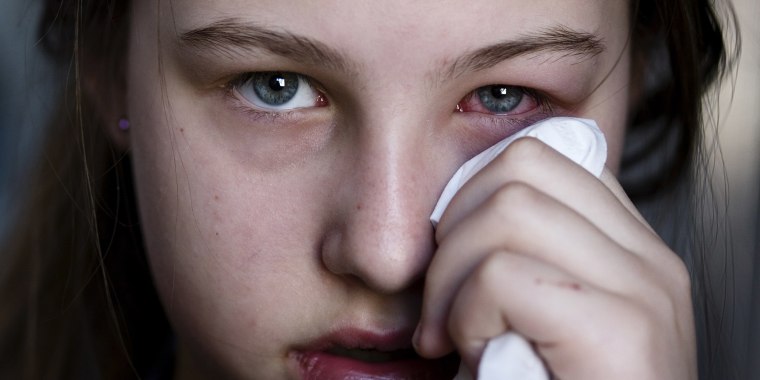The new coronavirus can spread through the eyes, prompting the world’s largest association of eye doctors to urge its members to be aware of the warning signs in patients.
The pathogen may cause pink eye, or conjunctivitis — inflammation of the clear tissue covering the white part of the eye — in about 1-3% of infected people, the American Academy of Ophthalmology said in an updated alert Tuesday.
Virus particles have been found in eye secretions, it previously warned, but a study published Wednesday suggests the risk of virus transmission through tears is low.
Download the TODAY app for the latest coverage on the coronavirus outbreak.
The group advised eye doctors to be on the lookout for patients who complained of pink eye — with symptoms including redness, swelling and sometimes a sticky discharge in one or both eyes — and who also had fever and respiratory symptoms such as cough and shortness of breath.
Red flags also included recent travel to places with known outbreaks of COVID-19, including parts of the U.S., China, Iran, Italy and South Korea, or contact with family members who recently came back from one of these areas.
Such patients “could represent cases of COVID-19,” the organization warned. Anyone experiencing pink eye would likely seek a doctor’s help, which “increases the likelihood ophthalmologists may be the first providers to evaluate patients possibly infected with COVID-19,” it noted, urging doctors to take precautions.
Some people have been reporting red eyes and eyelids as a symptom of COVID-19.
A nurse at the Life Care Center in Kirkland, Washington, which has been described as “ground zero for the West Coast's coronavirus outbreak,” observed many patients seemed to have peculiarly red eyes.
“They have, like ... allergy eyes. The white part of the eye is not red. It's more like they have red eye shadow on the outside of their eyes," Chelsey Earnest told CNN.
Such redness around the eye is the only report of this phenomenon the American Academy of Ophthalmology knows of at this time, said Dr. Sonal Tuli, a clinical spokeswoman for the group.
"In terms of a red shadow around the eyes, not on the white of the eyes, there is not enough data currently to suggest this is a symptom of COVID-19," Tuli said in a statement to TODAY.
"A shadowy look around the eyes may just be the result of extreme illness, and not necessarily a symptom specific to COVID-19 alone."
In general, inflammation of the eyelid is a common condition called blepharitis.
The Centers for Disease Control and Prevention does not list any eye symptoms as one of the warning signs of COVID-19.
Just because a person has pink eye doesn’t mean he or she is infected with coronavirus, the American Academy of Ophthalmology emphasized.
“Lots and lots of viruses cause pink eye,” Dr. Thomas Steinemann, a board-certified ophthalmologist at MetroHealth Medical Center in Cleveland, Ohio, and AAO spokesman, told TODAY.
“If you look at all of the pink eye (cases) every winter in the U.S., most of it is viral.”
Indeed, viral conjunctivitis is most commonly caused by contagious viruses associated with the common cold, the American Optometric Association noted. An upper respiratory infection either precedes the pink eye or happens at the same time, Steinemann said.
People catch the virus via a process that’s very familiar by now. A sick person coughs or sneezes, expelling respiratory droplets that can land on the face of someone nearby and enter through the eyes. Or a person can unwittingly touch a doorknob or another surface with the virus on it and then rub his or her eyes.
There’s no way to tell which virus caused the pink eye unless doctors swab the conjunctiva — the mucous membrane on the surface of the eye — and test the specimen, but that’s rarely done, Steinemann said.
To add to the confusion, it’s allergy season, when many people suffer from allergic conjunctivitis, an irritated eye due to a reaction to pollen.
The key symptom in those cases is itching, Steinemann noted. Viral conjunctivitis usually doesn’t produce itching.
How to protect your eyes during the coronavirus outbreak:
The American Academy of Ophthalmology had these tips:
- Contact lens wearers may want to switch to glasses for a while since they touch their eyes more than the average person.
- Wearing glasses, including sunglasses, can shield your eyes from other people’s respiratory droplets, though they don’t provide 100% security.
- Avoid rubbing your eyes to lower your risk of infection.


